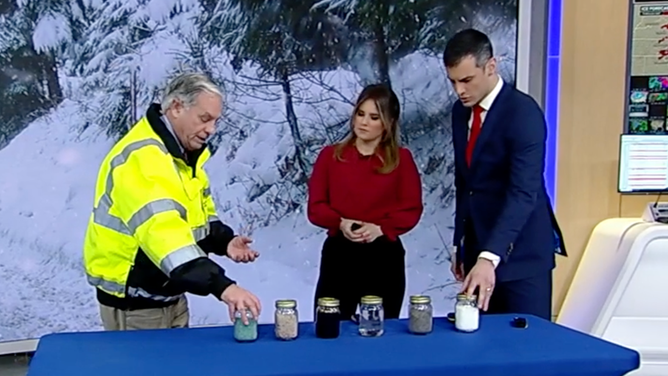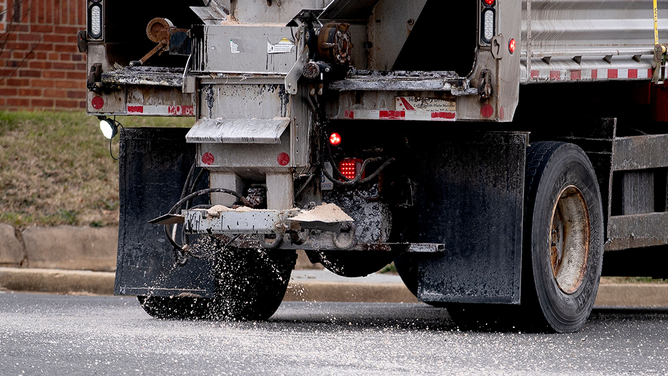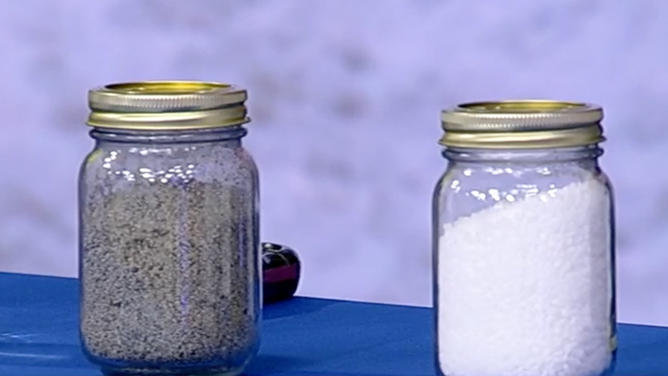What it takes to de-ice roads during winter storms
Treatments involving salt, brine and magnesium chloride may be used to keep roads clear of ice and snow.
Salt, brine or sand? Which to use when preparing for a winter storm
This weekend's nor'easter will bring snow, ice and slush to the roads across the Northeast. While salt is the go-to for avoiding slick surfaces, other options are available. So, what conditions require using those solutions, and what are the differences between each? James Tedesco, Bergen County, New Jersey, executive and acting director of Public Works, joins FOX Weather to sort this all out ahead of the storm.
Public works officials use several tactics to ensure that roads remain clear and safe for drivers during the winter.
Before any roads are treated, the first step officials take is to look at the weather forecast.
Seeing what kind of winter weather is approaching and when allows officials to develop a strategy to address the ice, snow and slippery road conditions, according to James Tedesco, Bergen County, New Jersey's executive and acting director of public works.

Tedesco shows FOX Weather meteorologists Jane Minar and Ian Oliver the different types of treatments used to keep roads clear of ice. Jan. 5, 2024.
(FOX Weather / FOX Weather)
Knowing what is in store for their area, crews then decide what kind of winter road treatments to use.
The first step is to spray brine, which is essentially water saturated with salt. Brine can be clear, or it can be pickled beet juice, which is a thicker and more environmentally friendly option, Tedesco said.
STATES TURN TO SUGAR BEETS FOR ECO-FRIENDLY ALTERNATIVE TO ROAD SALT TO DEICE ROADS
Brine helps with the next step of treating slippery roads: salting them. According to Tedesco, brine helps the salt stick to the road more effectively.
A few types of salt and other materials have been used to de-ice roads.

FILE: A snowplow salts and sands a street in Washington, DC, on January 16, 2022, ahead of a winter storm.
(STEFANI REYNOLDS/AFP via Getty Images / Getty Images)
The traditional option is basic rock salt. However, Tedesco said it is only most effective until temperatures drop to about 25 to 28 degrees.
An alternative to basic rock salt that has a lower temperature threshold is rock salt treated with a brine solution, he noted. This type of salt is more expensive, but given that it provides a better temperature range for roads, it has become more frequently used in the Northeast.
Another way to treat roads involves using magnesium chloride, according to Tedesco. Magnesium chloride is used for concrete surfaces, such as sidewalks and garages. However, its temperature threshold is not as low as that of rock salt treated with a brine solution.

A jar of sand (left) and a jar of magnesium chloride (right).
(FOX Weather / FOX Weather)
One treatment that is not typically used anymore is sand. Tedesco said sand on roadways can become hazardous, as it picks up oil, gasoline and other materials on the roads. Additionally, the sand needs to be cleaned up after a storm. In an emergency, though, sand can be mixed with rock salt to help provide traction on the roads.
DRIVING ON THE ICE AND DRIVING IN THE SNOW
No matter the treatment used, Tedesco said watching the weather forecast is critical in helping his team decide when to lay down the salt and brine.

FILE: An excavator piles road salt in preparation for Winter Storm Kenan at the Boston Public Works Department yard on January 28, 2022 in Boston, Massachusetts.
( Scott Eisen / Getty Images)
For example, rain right before a snowstorm could wash away any brine and salt that had been used to treat roads. By keeping a close eye on the forecast, Tedesco, his team and other public works officials can time their treatments in a way that is most effective.
To best treat the roads, Tedesco noted that his team goes out and places a base layer of rock salt onto the roads. The cars and tires then grind the salt into the pavement, giving a solid foundation and preventing the formation of ice on the road.
